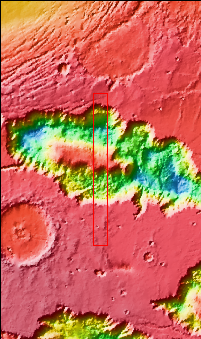
|
Hebes Chasma
- Click the image above for a larger view
- Full-Res JPEG (604 x 2704) (76.2 kB)
- Full-Res TIFF (604 x 2704) (697.3 kB)
Caption:

Context image
Today's VIS image crosses the entirety of Hebes Chasma, including the central rise called Hebes Mensa. Located in the center of the image, Hebes Mensa is 7.5 km (4.7 miles) tall and 120 by 43 km (75 by 27 miles) wide. The surrounding Hebes Chasma is is 319 km long (east/west, 198 miles), 130 km wide (north/south, 81miles) and up to 8km (5 miles) deep. Hebes Chasma is an inclosed basin not connected to Valles Marineris. Hebes Mensa is a large deposit of layered materials, and the cliff faces are eroding in a very different way from the Hebes Chasma cliffs.
Orbit Number: 85967 Latitude: -1.25893 Longitude: 283.562 Instrument: VIS Captured: 2021-05-01 19:55
Background Info:
Please see the THEMIS Data Citation Note for details on crediting THEMIS images.
NASA's Jet Propulsion Laboratory manages the 2001 Mars Odyssey mission for NASA's Science Mission Directorate, Washington, D.C. The Thermal Emission Imaging System (THEMIS) was developed by Arizona State University, Tempe, in collaboration with Raytheon Santa Barbara Remote Sensing. The THEMIS investigation is led by Dr. Philip Christensen at Arizona State University. Lockheed Martin Astronautics, Denver, is the prime contractor for the Odyssey project, and developed and built the orbiter. Mission operations are conducted jointly from Lockheed Martin and from JPL, a division of the California Institute of Technology in Pasadena.
Cataloging Keywords:
| Name | Value | Additional Values |
|---|---|---|
| Target | Mars | |
| System | ||
| Target Type | Planet | |
| Mission | 2001 Mars Odyssey | Mariner |
| Instrument Host | Mars Odyssey | |
| Host Type | Orbiter | Flyby Spacecraft |
| Instrument | Thermal Emission Imaging System (THEMIS) | |
| Detector | ||
| Extra Keywords | Grayscale, Thermal | |
| Acquisition Date | ||
| Release Date | 2021-10-07 | |
| Date in Caption | 2021-05-01 | |
| Image Credit | NASA/JPL-Caltech/ASU | |
| Source | photojournal.jpl.nasa.gov/catalog/PIA24214 | |
| Identifier | PIA24214 | |
